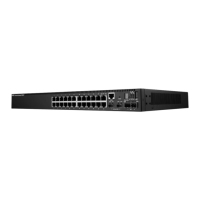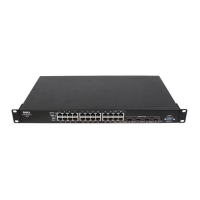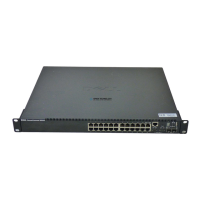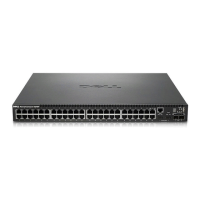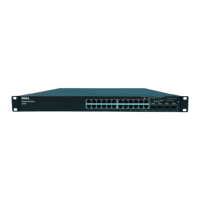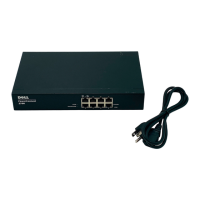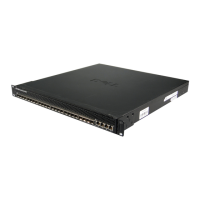
Do you have a question about the Dell PowerConnect 5424 and is the answer not in the manual?
| Ports | 24 x 10/100/1000Base-T |
|---|---|
| Switching Capacity | 48 Gbps |
| Forwarding Rate | 35.7 Mpps |
| VLAN Support | Yes |
| Rack Mountable | Yes |
| Power Supply | Internal |
| MAC Address Table Size | 8K entries |
| RAM | 128 MB |
| Flash Memory | 16 MB |
| Voltage Required | 100-240V AC |
| Management | Web, CLI, SNMP |
| Operating Temperature | 0°C to 45°C |
| Storage Temperature | -20°C to 70°C |
| Humidity | 10% to 90% (non-condensing) |
| Standards Compliance | IEEE 802.3, IEEE 802.3u, IEEE 802.3ab |
| Remote Management Protocol | SNMP, RMON, Telnet |
| Features | QoS, VLAN, Link Aggregation |
Details the two versions of PowerConnect 54xx series systems: 5424 and 5448.
Describes user-configurable features including IP Version 6, Head of Line Blocking, Virtual Cable Testing, Jumbo Frames, MDI/MDIX, and Flow Control.
Covers IGMP Snooping, Port Mirroring, and Broadcast Storm Control functionalities.
Explains VLAN support, Port Based VLANs, IEEE802.1V Protocol Based VLANs, 802.1Q Tagging, QinQ, and GVRP.
Details Spanning Tree Protocol (STP), Fast Link, IEEE 802.1w Rapid Spanning Tree, STP Root Guard, and Multiple Spanning Tree (MSTP).
Describes Link Aggregation (LAG) capabilities, including fault tolerance and higher bandwidth connections.
Covers Address Resolution Protocol (ARP), TCP, BootP and DHCP Clients, and Quality of Service (QoS) features.
Details SNMP Alarms and Trap Logs, SNMP Versions, Web Based Management, Configuration File Download/Upload, TFTP, and Remote Monitoring.
Explains Command Line Interface (CLI), Syslog, SNTP, Traceroute, LLDP-MED, and SSL security protocols.
References the CLI Reference Guide for detailed information on CLI commands.
Details the front panel port configuration including copper and fiber ports, and the terminal port.
Describes the back panel connectors for power and the RS-232 console port.
Details SFP Ports, RS-232 Console Port, and Combo Ports with their respective connections.
Provides the physical dimensions of the device: height, width, and depth.
Explains the meaning of front panel LEDs for port status, power supplies, fans, and system diagnostics.
Details the device's internal and external power supplies, reset button, and ventilation system.
Lists critical safety instructions and precautions before installing the device.
Specifies general, power, clearance, cabling, and ambient requirements for installation.
Covers package contents and procedures for safely unpacking the device.
Provides instructions for mounting the system in a rack or on a flat surface.
Details how to connect the device to a terminal and to a power supply.
Explains physical interfaces, port connections, connector types, and RJ-45 pinout.
Describes auto-negotiation, MDI/MDIX, Flow Control, Back Pressure, and default port settings.
Ensures the terminal emulation software is set correctly for device configuration.
Details the process of booting the device, including Power On Self Test (POST).
Guides through the initial setup wizard for IP address, subnet mask, and security.
Covers dynamic IP address allocation via DHCP/BOOTP and security management.
Details how to configure passwords for Terminal, Telnet, SSH, HTTP, and HTTPS services.
Explains procedures accessible from the startup menu, such as software download and password recovery.
Describes the Switch Administrator interface, including Tree View and Device View.
Explains the function of Information Buttons and Device Management Buttons.
Provides steps to open and start the Dell PowerConnect OpenManage Switch Administrator.
Details methods for accessing the device via Console Connection or Telnet Connection.
Explains CLI command modes: User EXEC, Privileged EXEC, Global Configuration, and Interface Configuration.
Covers system name, location, MAC address, date, time, and system uptime configuration.
Details system time parameters, SNTP clock, and Daylight Savings Time rules for various countries.
Explains how to view power supply and fan status through the System Health page.
Provides information on current software, boot, and hardware versions running on the device.
Describes how to reset the device remotely or via CLI commands.
Details SNTP configuration, including global parameters, authentication, and servers.
Covers System Logs, Global Log Parameters, RAM Log Table, and Log File Table configuration.
Details how to view and configure remote log servers and set severity levels.
Covers IP addressing, IPv6 configuration, default gateways, and DHCP/BOOTP parameters.
Explains how to perform virtual cable tests on copper and fiber optic cables.
Covers Access Profiles, Authentication Profiles, Password Management, Local User Databases, Line Passwords, Enable Passwords, TACACS+, RADIUS, and LLDP.
Details Link Layer Discovery Protocol (LLDP) and LLDP-MED for network management and topology discovery.
Covers SNMP configuration, including Global Parameters, View Settings, Access Control, Groups, User Security, Communities, and Notification Filters.
Enables network security using Access Control Lists and Locked Ports.
Details advanced port-based authentication settings for multiple hosts and sessions.
Displays user port access lists and details authentication methods and MAC addresses.
Limits port access to specific MAC addresses and monitors received/learned packets.
Explains Access Control Lists (ACLs) for defining classification actions and rules for ingress ports.
Allows definition of MAC-based ACLs, including ACEs, priority, and source/destination addresses.
Binds ACLs to interfaces, applying ACE rules to selected ports or LAGs.
Enhances network security by providing firewall security between untrusted interfaces and DHCP servers.
Provides links to port functionality pages including Storm Control and Port Mirroring.
Enables even distribution of data and processing packets across network resources.
Configures Storm Control to limit broadcast, multicast, and unicast frames.
Monitors and mirrors network traffic by forwarding copies of packets from one port to a monitoring port.
Manages MAC addresses in Static and Dynamic Address databases.
Registers network connectivity and membership information for VLANs or Multicast addresses.
Provides tree topography for bridge arrangements, preventing loops and ensuring single paths.
Defines logical subgroups of a LAN, allowing efficient traffic flow and software-based network changes.
Enhances VoIP service by configuring ports for IP voice traffic with QoS support.
Optimizes port usage by linking ports into a single Link Aggregated Group (LAG) for bandwidth and redundancy.
Allows single packets to be forwarded to multiple destinations using L2 switch services.
Handles IGMP members, enabling the device to learn multicast groups and monitor ports.
Provides links to display statistics in a chart form, including Utilization Summary and Counter Summary.
Shows statistics for both received and transmitted packets on ports or LAGs.
Displays interface statistics related to Etherlike frames, including FCS errors and collisions.
Contains device statistics for GARP VLAN Registration Protocol (GVRP).
Provides information about EAP packets received on a specific port.
Offers links for viewing network information from a remote location via RMON.
Contains information about samples of data taken from ports for RMON history control.
Defines network alarms that occur when a network problem or event is detected.
Lists RMON events, including event number, log number, log time, and description.
Provides links for displaying statistics in a chart form.
Displays statistics in a chart form for port elements.
Contains fields for opening statistics in a chart form for LAGs.
Shows system CPU utilization and percentage of CPU resources consumed by each stacking member.
Specifies packet fields matched to specific values for classifying traffic.
Defines traffic management based on packet information and field values like VLAN priority.
Details VLAN Priority Tag usage for classifying packets and mapping to output queues.
Sets Class of Service (CoS) global parameters, including CoS Mode and Trust Mode.
Defines QoS/CoS settings per interface, including Trust Mode and default CoS tag values.
Configures bandwidth settings for egress interfaces, including shaping rate and burst size.
Configures scheduling methods for queues, including Strict Priority and Weighted Round Robin (WRR).
Classifies CoS settings to traffic queues by mapping CoS values to specific output queues.
Defines output queue mapping for specific DSCP fields.
Describes port types (RJ-45, SFP) and port settings like Auto-negotiation and Storm Control.
Details operating temperatures and humidity requirements for the device.
Provides physical device specifications including unit size and ventilation.
Lists the device memory specifications: CPU DRAM, Flash Memory, and Packet Buffer Memory.
Summarizes key features: VLAN, Quality of Service, Layer 2 Multicast, Device Security, Additional Switching Features, Device Management, and System Features.
